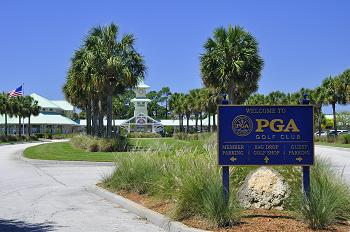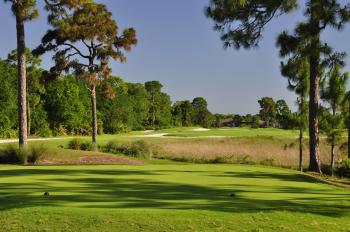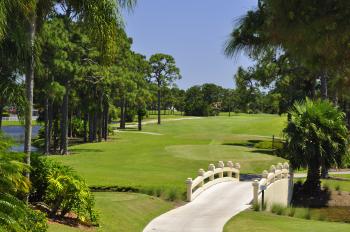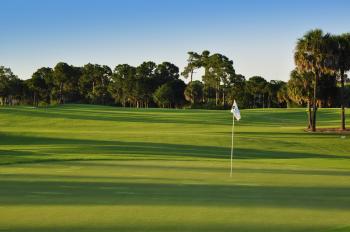
Welcome to 1916 Perfect Drive
It is more than fitting that one of the best golf resorts in the U.S is located on a street called Perfect Drive. 1916 Perfect Drive to be exact, the address of the PGA Village in Port St. Lucie, Florida. Equally appropriate is the inclusion of 1916 in the address. A random numerical selection you ask? Not a chance, as this was the year the PGA of America was established and a small, but significant example of the thought and detail that was expended to create this perfect golf destination.
PGA Village. The name itself suggests this place is all about golf. Featuring a collection of four exceptional golf courses sprawled over 500 acres, this vibrant community is nestled fifty-five miles north of West Palm Beach along Florida’s “Treasure Coast”. Over the last twenty years, the property has received more accolades from the likes of Golf Digest, Golf World and Travel & Leisure Golf than I can possibly list.

Wanamaker Course
In much of its promotional literature, the PGA Village describes itself as the place for golfers to “play, stay, live and learn”. With 54 holes of golf designed by Tom Fazio and Pete Dye, the “play” part of this byline is more than adequately covered. Fazio is the brains behind two of the courses respectfully named the Ryder and Wanamaker after golf pioneers Samuel Ryder, the namesake and founder of the Ryder Cup, and Rodman Wanamaker, the New York City department store magnate, who was one of the founding fathers of the PGA of America. The third is simply known as the Dye Course, a golf visionary in his own right. All are equally impressive and should be experienced. Don’t get consumed in the useless banter of “which course is best”. If you talk to ten different people you’ll get ten different answers. My advice – play them all and come to your own conclusion. After eighteen holes on the Dye Course, you’ll likely concede it’s the toughest of the three, but I’m sure you’ll agree Fazio’s designs are anything but a walk in the park.
The fourth and lesser-known golf course is the St. Lucie Trail Golf Club (formerly the PGA Country Club), a Jim Fazio Sr. design that was recently adopted into the PGA Village family. The course is located a short five minute drive away on the opposite side of I-95 and provides visitors with another PGA Village championship golf experience.

The Dye Course
For hard-core golf enthusiasts and history buffs, the PGA of America has something especially for you. This is the “learn” part of the PGA mantra and is comprised of two parts. The first is the 35-acre PGA Learning Centre that features 100 hitting stations and multiple short game and putting green areas. There is also a 3-hole short course and, as you would expect, the latest golf swing analysis equipment including Trackman. Want to improve your game? This is the place to come. A variety of total game improvement golf schools are offered year round to help you do this.
The second part, and personal favorite, is the PGA Museum of Golf. For anyone that comes to PGA Village, this is a “must do” activity regardless of your age or knowledge of the game. Located on property, the museum is a historical showcase that features modern and ancient golf artifacts and memorabilia including Donald Ross’ workbench from 1900 and the Rodman Wanamaker trophy, the PGA of America’s coveted cup awarded annually since 1916 to golf’s final major champion. The museum also has a special section dedicated to Ryder Cup history and one of golf’s largest libraries, including the oldest-known mention of the game from the Scottish Acts of Parliament dating back to 1566. Best of all, the PGA Museum of Golf is open seven days a week during the season and admittance is free.

The St. Lucie Trail Golf Club
Next is the “stay” part in the PGA Village equation. Not surprising, the accommodations available at the village are more than satisfactory. I recommend one of two options, both of which are a mere pitching wedge away from the first tee of the Ryder, Wanamaker and Dye courses. The first is the Hilton Garden Inn, a clean and comfortable hotel located at the front entrance of the property and home to Sam Snead’s Oak Grill and Tavern. The restaurant itself is an attraction as pictures from Mr. Snead’s 82 tournament wins, including seven major victories, adorn the walls throughout. The second option is to stay in a golf villa on Perfect Drive. I’m particularly fond of the condos in Castle Pines as these 1,000 sq. ft., two-bedroom units provide all the comforts and amenities of home.
And finally, there is the “live” segment, the last part of the PGA Village message. I thoroughly enjoyed my time at the village having experienced all the facility had to offer. I won’t disclose the number of rounds I played, but I will confess that I played more golf in five days than most of my friends play all year. What can

The Ryder Course
I say. I loved this part of the sunshine state and concluded that this is the ideal place to be January through March for anyone interested in saying adios to our nasty and persistent Canadian winters.
Anyone who plays the game would agree that the words “perfect” and “golf” are anything but synonymous. Fortunately the PGA of America has figured out a way to link the words together. As you arrive at 1916 Perfect Drive you’ll know what I mean. The PGA Village really is perfect in every way.
Fast Facts
Contact Information
PGA Village – 1-800-800-4653, www.pgavillage.com
PGA Museum of Golf – www.pga.com/museum
Hilton Garden Inn at PGA Village, Port St. Lucie – 1-772-871-6850, www.portstlucie.hgi.com
Castle Pines Golf Villas – 1-772-873-0515, www.perfectdriveatpgavillage.com
Sam Snead’s Oak Grill & Tavern – 1-772-293-0726, www.samsneadstavern.com
